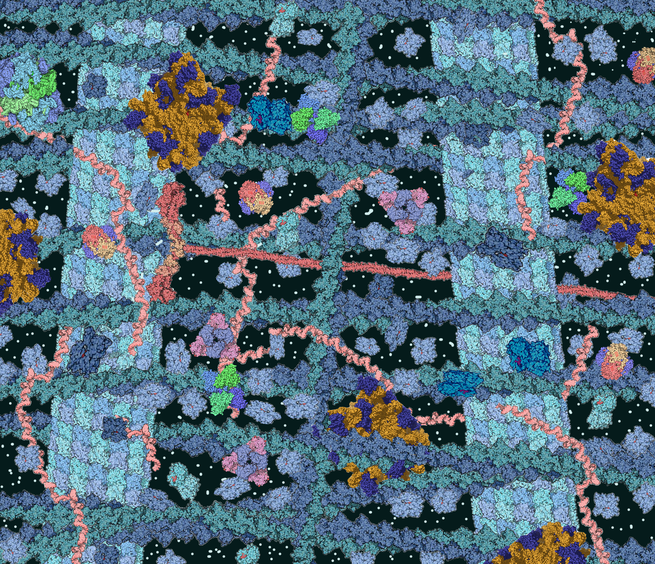
Main Difference
The main difference between Cytosol and Cytoplasm is that the Cytosol is a The part of the cytoplasm that does not contain organelles but which does contain other particulate matter, such as protein complexes and Cytoplasm is a All of the contents of a cell excluding the plasma membrane and nucleus, but including other subcellular structures.
-
Cytosol
The cytosol, also known as intracellular fluid (ICF) or cytoplasmic matrix, is the liquid found inside cells. It is separated into compartments by membranes. For example, the mitochondrial matrix separates the mitochondrion into many compartments.
In the eukaryotic cell, the cytosol is surrounded by the cell membrane and is part of the cytoplasm, which also comprises the mitochondria, plastids, and other organelles (but not their internal fluids and structures); the cell nucleus is separate. The cytosol is thus a liquid matrix around the organelles. In prokaryotes, most of the chemical reactions of metabolism take place in the cytosol, while a few take place in membranes or in the periplasmic space. In eukaryotes, while many metabolic pathways still occur in the cytosol, others are contained within organelles.
The cytosol is a complex mixture of substances dissolved in water. Although water forms the large majority of the cytosol, its structure and properties within cells is not well understood. The concentrations of ions such as sodium and potassium are different in the cytosol than in the extracellular fluid; these differences in ion levels are important in processes such as osmoregulation, cell signaling, and the generation of action potentials in excitable cells such as endocrine, nerve and muscle cells. The cytosol also contains large amounts of macromolecules, which can alter how molecules behave, through macromolecular crowding.
Although it was once thought to be a simple solution of molecules, the cytosol has multiple levels of organization. These include concentration gradients of small molecules such as calcium, large complexes of enzymes that act together to carry out metabolic pathways, and protein complexes such as proteasomes and carboxysomes that enclose and separate parts of the cytosol.
-
Cytoplasm
In cell biology, the cytoplasm is the material within a living cell, excluding the cell nucleus. It comprises cytosol (the gel-like substance enclosed within the cell membrane) and the organelles – the cell’s internal sub-structures. All of the contents of the cells of prokaryotic organisms (such as bacteria, which lack a cell nucleus) are contained within the cytoplasm. Within the cells of eukaryotic organisms the contents of the cell nucleus are separated from the cytoplasm, and are then called the nucleoplasm. The cytoplasm is about 80% water and usually colorless.
The submicroscopic ground cell substance or cytoplasmatic matrix which remains after exclusion the cell organelles and particles is groundplasm. It is the hyaloplasm of light microscopy, and high complex, polyphasic system in which all of resolvable cytoplasmic elements of are suspended, including the larger organelles such as the ribosomes, mitochondria, the plant plastids, lipid droplets, and vacuoles.
It is within the cytoplasm that most cellular activities occur, such as many metabolic pathways including glycolysis, and processes such as cell division. The concentrated inner area is called the endoplasm and the outer layer is called the cell cortex or the ectoplasm.
Movement of calcium ions in and out of the cytoplasm is a signaling activity for metabolic processes.
In plants, movement of the cytoplasm around vacuoles is known as cytoplasmic streaming.
-
Cytosol (noun)
The aqueous solution of a cell’s cytoplasm, consisting of water, organic molecules and inorganic ions.
-
Cytoplasm (noun)
The contents of a cell except for the nucleus. It includes cytosol, organelles, vesicles, and the cytoskeleton.
